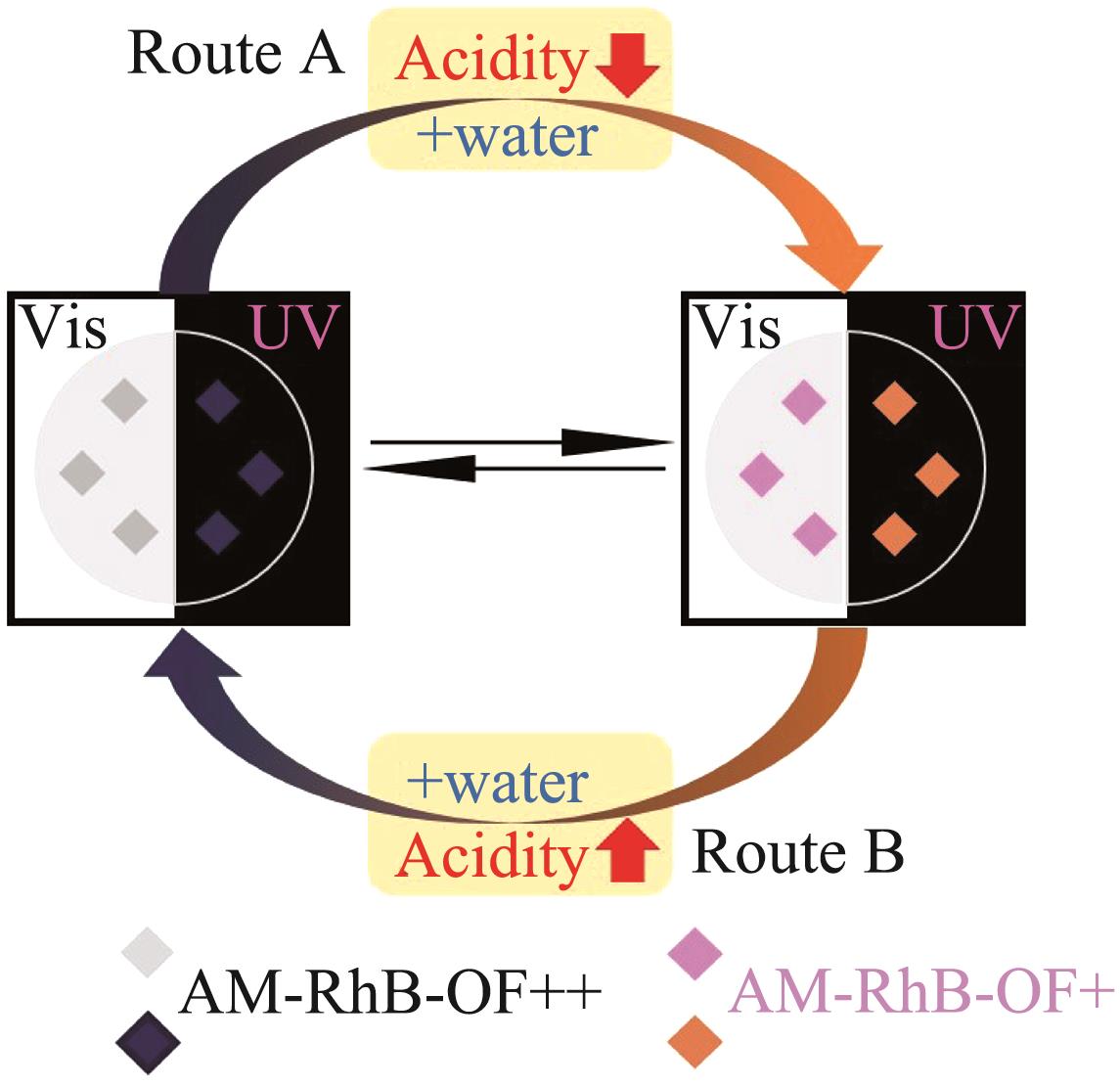
Chinese Journal of Applied Chemistry ›› 2022, Vol. 39 ›› Issue (7): 1119-1128.DOI: 10.19894/j.issn.1000-0518.210334
• Full Papers • Previous Articles Next Articles
Off‑on/On‑off Dual‑Mode Hydrochromic Materials: Water‑Induced Acidity Changes in the Microenvironment Regulate the Color Switching of Rhodamine Derivatives
Xiao-Yan WEI, Jin-Yan ZHANG, Lan SHENG( ), Sean Xiao-An ZHANG
), Sean Xiao-An ZHANG
- State key Laboratong of Supramolecular Strccture and Materiats,Jilin University,Changchun 130012,China
-
Received:2021-07-09Accepted:2021-10-22Published:2022-07-01Online:2022-07-11 -
Contact:Lan SHENG -
About author:shenglan17@jlu.edu.cn
-
Supported by:the National Natural Science Foundation of China(21975099);the Outstanding Youth Talent Fund Project of Jilin Provincial Science and Technology Development Program(20190103126JH)
CLC Number:
Cite this article
Xiao-Yan WEI, Jin-Yan ZHANG, Lan SHENG, Sean Xiao-An ZHANG. Off‑on/On‑off Dual‑Mode Hydrochromic Materials: Water‑Induced Acidity Changes in the Microenvironment Regulate the Color Switching of Rhodamine Derivatives[J]. Chinese Journal of Applied Chemistry, 2022, 39(7): 1119-1128.
share this article
Add to citation manager EndNote|Ris|BibTeX
URL: http://yyhx.ciac.jl.cn/EN/10.19894/j.issn.1000-0518.210334
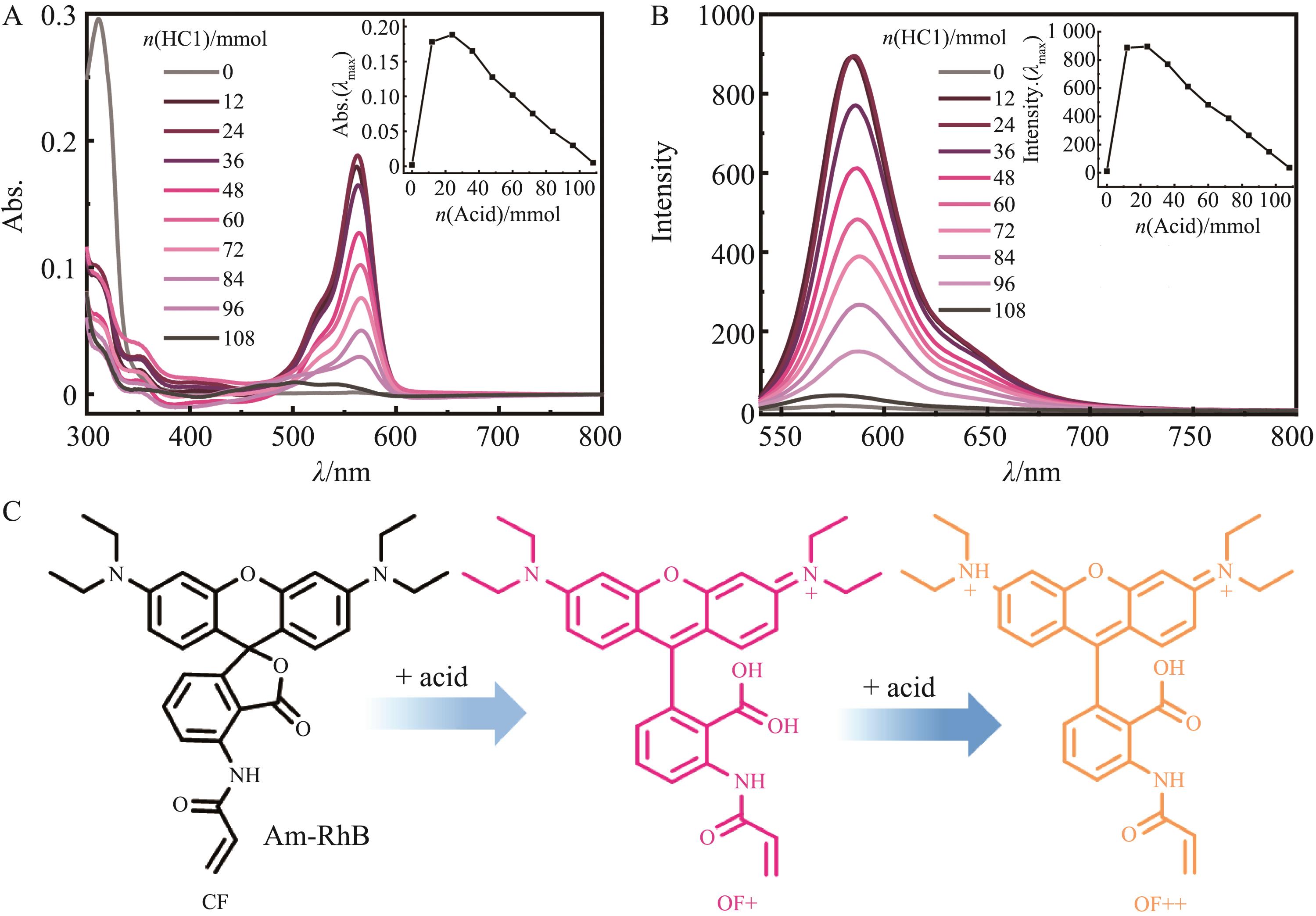
Fig.1 (A) UV-Vis absorption spectra and (B) fluorescent emission spectra of AM-RhB in THF with different molar of hydrochloric acid (n(AM-RhB)=0.3 mmoL,V(AM-RhB)=3 mL, λex = 530 nm, slit width: 3 nm, 3 nm); (C) Structural changes of molecules in solution
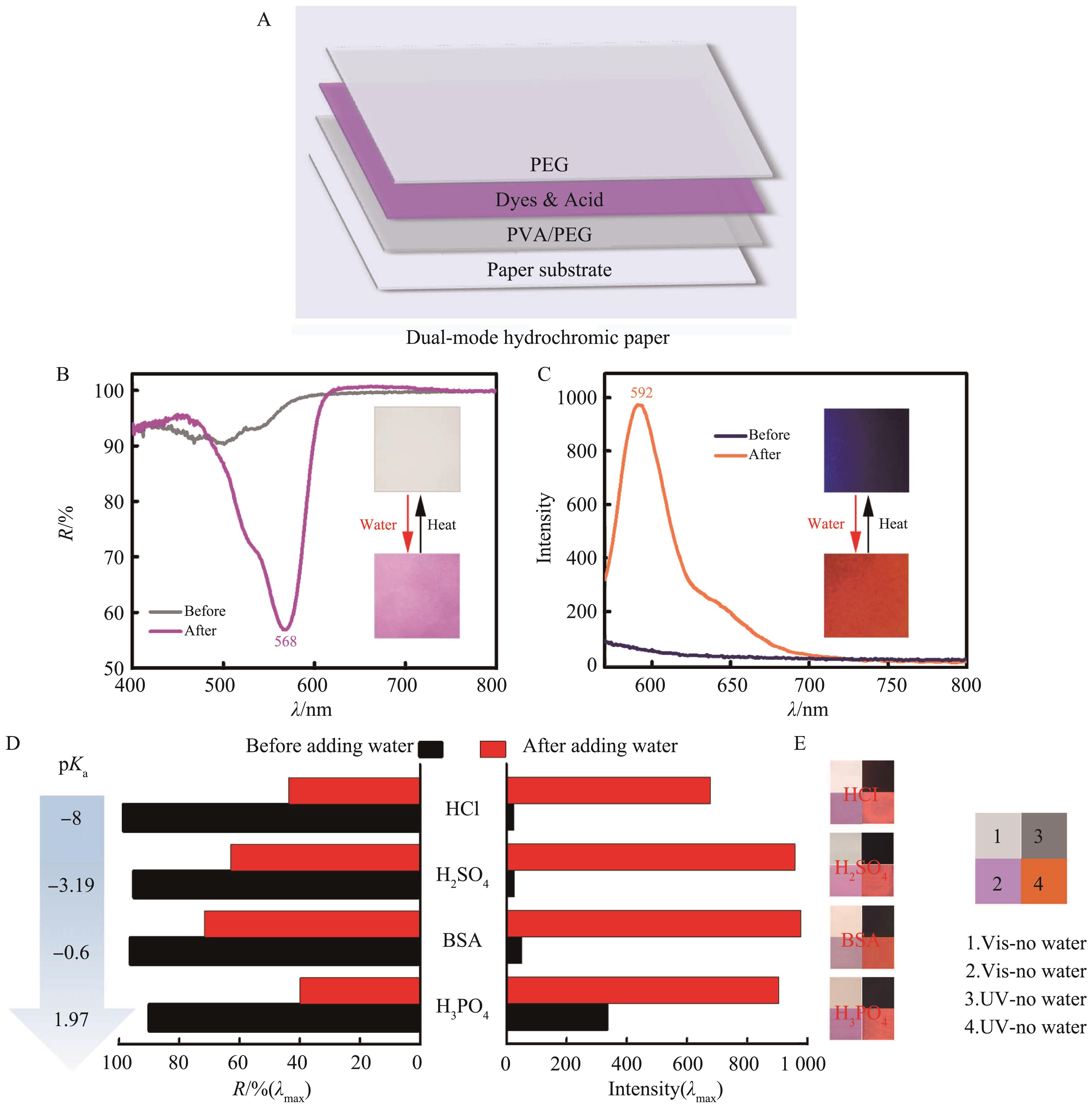
Fig.3 (A) Schematic diagram of the material structure; (B) The UV-Vis reflective spectra and (C) fluorescence emission spectra of the “off-on” mode material before and after adding water (λex=560 nm, slit width: 5 nm, 3 nm); (D) Plot of visible reflection(left) and fluorescent emission intensity(right) at λmax of hydrochromic fluorescent materials based on different acid (λex = 560 nm, slit width: 5 nm,3 nm);(E) Picture of materials in different condition
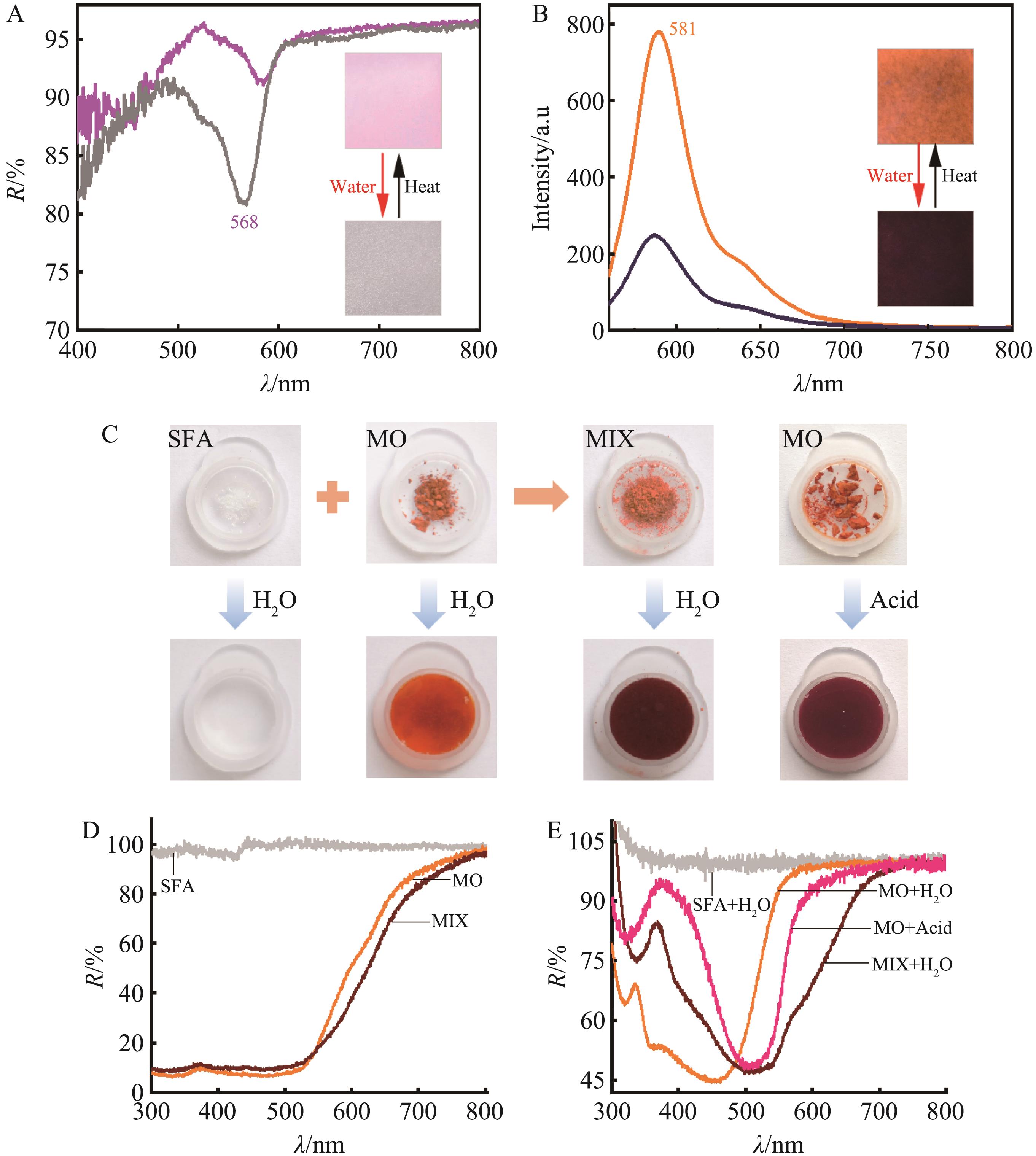
Fig.4 (A) The UV-Vis reflective spectra and (B) fluorescence emission spectra of the “on-off” mode material before and after adding water (λex = 550 nm, slit width: 5 nm, 3 nm); The change of (C) color and (D,E) visible reflection of SFA, MO and mixture before and after adding water
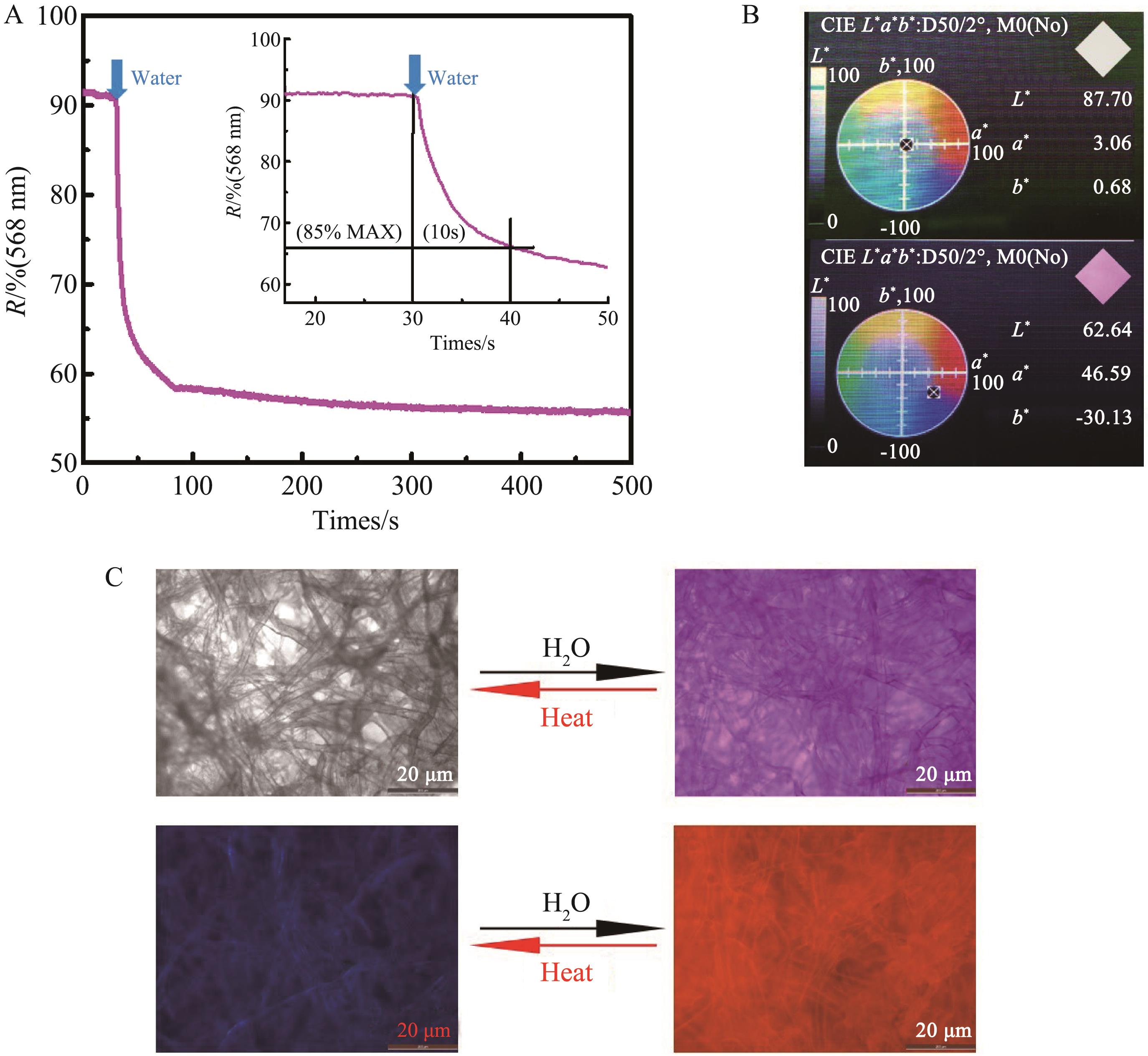
Fig.5 (A) Time-dependent reflectivity variations at 568 nm for AM-RhB based WJRP upon adding a droplet of water during 0~500 s, respectively. Blue arrows indicate the moment of adding water. (B) L*, a*, b* measured by spectrodensitometer and photographs of the “off-on” mode paper before (up) and after (down) adding water, respectively. (C) Microscopic images (up) and fluorescence images (down) of the “off-on” mode paper before and after addition of water
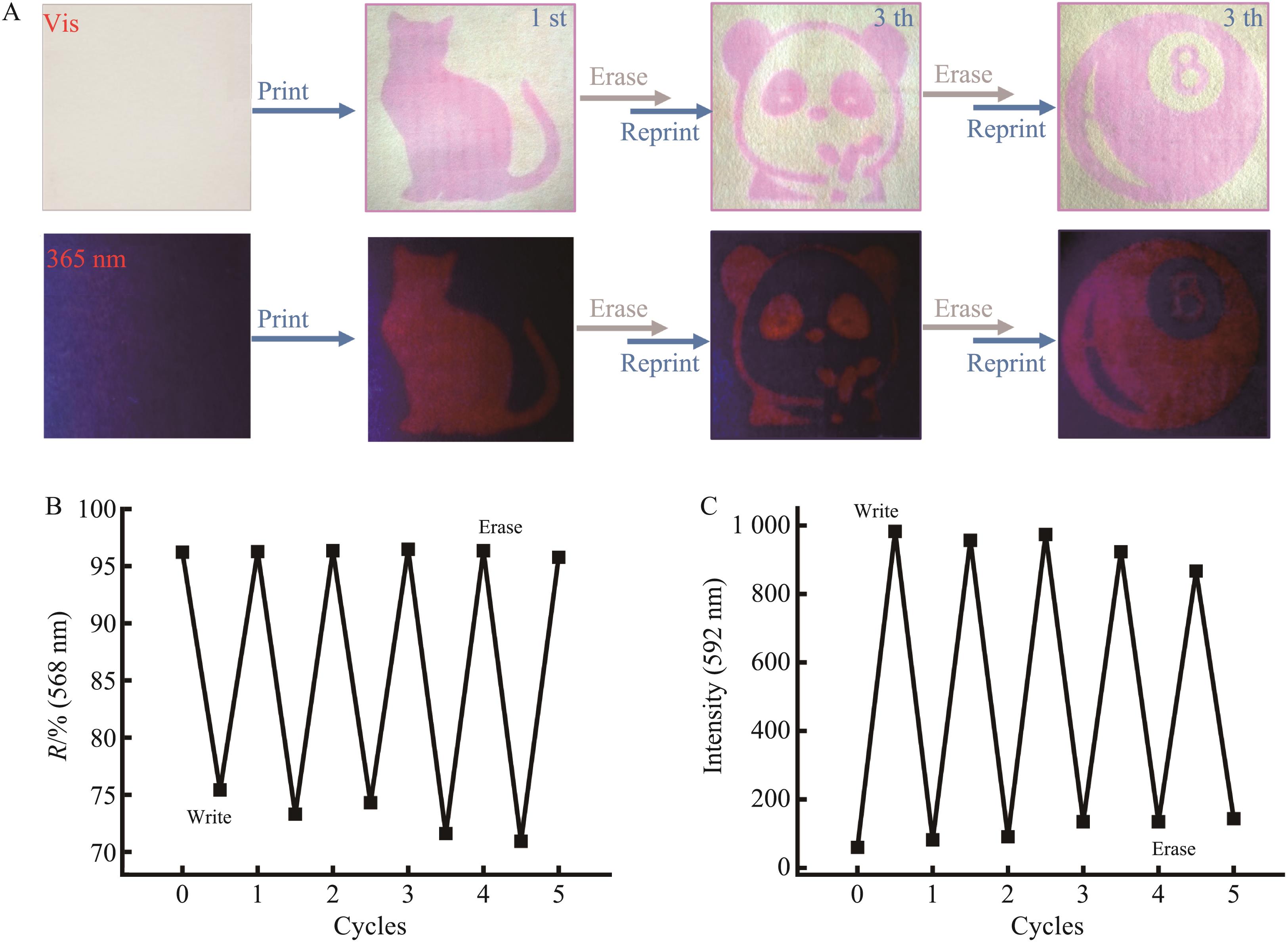
Fig.6 (A) Photographs during 5 consecutive print-erase rounds on the dual-mode hydrochromic paper. (B) A plot of the reflectivity at 568 nm and (C) fluorescent intensity at 592 nm versus the number of cycles as the WJRP is cycled through water spraying (Write) and water removal (Erase) by means of wetting/heating at 60 ℃ (λex = 560 nm, slit width: 5 nm, 3 nm)
| 1 | TIAN E, WANG J, ZHENG Y, et al. Colorful humidity sensitive photonic crystal hydrogel[J]. J Mater Chem, 2008, 18(10): 1116-1122. |
| 2 | KIM E, KIM S Y, JO G, et al. Colorimetric and resistive polymer electrolyte thin films for real-time humidity sensors[J]. ACS Appl Mater Interfaces, 2012, 4(10): 5179-5187. |
| 3 | WANG Z, ZHANG J, XIE J, et al. Bioinspired water-vapor-responsive organic/inorganic hybrid one-dimensional photonic crystals with tunable full-color stop band[J]. Adv Funct Mater, 2010, 20(21): 3784-3790. |
| 4 | GEORGAKI M I, BOTSIALAS A, ARGITIS P, et al. 1-D polymeric photonic crystals as spectroscopic zero-power humidity sensors[J]. Microelectron Eng, 2014, 115: 55-60. |
| 5 | HAWKEYE M M, BRETT M J. Optimized colorimetric photonic-crystal humidity sensor fabricated using glancing angle deposition[J]. Adv Funct Mater, 2011, 21(19): 3652-3658. |
| 6 | XUAN R, WU Q, YIN Y, et al. Magnetically assembled photonic crystal film for humidity sensing[J]. J Mater Chem, 2011, 21(11): 3672-3676. |
| 7 | SHENG L, LI M, ZHU S, et al. Hydrochromic molecular switches for water-jet rewritable paper[J]. Nat Commun, 2014, 5: 3044. |
| 8 | XI G, SHENG L, ZHANG I, et al. Endowing hydrochromism to fluorans via bioinspired alteration of molecular structures and microenvironments and expanding their potential for rewritable paper[J]. ACS Appl Mater Interfaces, 2017, 9(43): 38032-38041. |
| 9 | XI G, SHENG L, DU J, et al. Water assisted biomimetic synergistic process and its application in water-jet rewritable paper[J]. Nat Commun, 2018, 9: 4819. |
| 10 | GAO W, QIN T, XI G, et al. Microenvironments induced ring-closing of halide salts of oxazolidines: a rare inverse proton gradient process and its application in water-jet rewritable paper[J]. J Mater Chem C, 2018, 6(40): 10775-10781. |
| 11 | QIN T, HAN J Q, GENG Y, et al. A multiaddressable dyad with switchable cyan/magenta/yellow colors for full-color rewritable paper[J]. Chem Eur J, 2018, 24(48): 12539-12545. |
| 12 | QIN T, SHENG L, ZHANG X A. Highly tunable multicolor water-jet rewritable paper based on simple new-type dual-addressable oxazolidines[J]. ACS Appl Mater Interfaces, 2018, 10(47): 40838-40843. |
| 13 | SAMANTA D, GALAKTIONOVA D, GEMEN J, et al. Reversible chromism of spiropyran in the cavity of a flexible coordination cage[J]. Nat Commun, 2018, 9: 641. |
| 14 | LIU Y, FAN M, ZHANG C, et al. Waterchromism of protonated photomerocyanine dye[J]. Dyes Pigm, 2008, 76(1): 264-269. |
| 15 | LEE J, PYO M, LEE S H, et al. Hydrochromic conjugated polymers for human sweat pore mapping[J]. Nat Commun, 2014, 5: 3736. |
| 16 | PARK D H, JEONG W, SEO M, et al. Inkjet-printable amphiphilic polydiacetylene precursor for hydrochromic imaging on paper[J]. Adv Funct Mater, 2016, 26(4): 498-506. |
| 17 | SEO M, PARK D H, PARK B J, et al. Flexible patch-type hydrochromic polydiacetylene sensor for human sweat pore mapping[J]. J Appl Polym Sci, 2017, 134(6): 44419-44426. |
| 18 | 鞠乐, 张婷, 秦天游, 等. 通过开关单元调节赋予荧烷水致变色性质及喷水打印应用[J]. 应用化学, 2019, 36(2): 137-145. |
| JU L, ZHANG T, QIN T Y, et al. Endowing hydrochromism to fluoranes by modifying their switch sites and their applications in water-jet printing[J]. Chinese J Appl Chem, 2019, 36(2): 137-145. | |
| 19 | OOYAMA Y, SUMOMOGI M, NAGANO T, et al. Detection of water in organic solvents by photo-induced electron transfer method[J]. Org Biomol Chem, 2011, 9(5): 1314-1316. |
| 20 | OOYAMA Y, MASTUGASAKO A, OKA K, et al. Fluorescence PET (photo-induced electron transfer) sensors for water based on anthracene-boronic acid ester[J]. Chem Commun, 2011, 47(15): 4448-4450. |
| 21 | OOYAMA Y, MATSUGASAKO A, NAGANO T, et al. Fluorescence PET (photo-induced electron transfer) sensor for water based on anthracene-amino acid[J]. J Photochem Photobiol A, 2011, 222(1): 52-53. |
| 22 | OOYAMA Y, MATSUGASAKO A, Hagiwara Y, et al. Highly sensitive fluorescence PET (photo-induced electron transfer) sensor for water based on anthracene-bisboronic acid ester[J]. RSC Adv, 2012, 2(20): 7666-7668. |
| 23 | OOYAMA Y, AOYAMA S, FURUE K, et al. Fluorescence sensor for water based on PET (photo-induced electron transfer): anthracene-bis(aminomethyl)phenylboronic acid ester[J]. Dyes Pigm, 2015, 123: 248-253. |
| 24 | OOYAMA Y, UENAKA K, MATSUGASAKO A, et al. Molecular design and synthesis of fluorescence PET (photo-induced electron transfer) sensors for detection of water in organic solvents[J]. RSC Adv, 2013, 3(45): 23255-23263. |
| 25 | KIM K H, LEE W J, KIM J N, et al. An off-on fluorescent sensor for detecting a wide range of water content in organic solvents[J]. Korean Chem Soc, 2013, 34(8): 2261-2266. |
| 26 | THIRUMALAI R, MUKHOPADHYAY R D, PRAVEEN V K, et al. A slippery molecular assembly allows water as a self-erasable security marker[J]. Sci Rep, 2015, 5: 9842. |
| 27 | DENG Q, LI Y, WU J, et al. Highly sensitive fluorescent sensing for water based on poly(m-aminobenzoic acid)[J]. Chem Commun, 2012, 48(24): 3009-3011. |
| 28 | DING L, ZHANG Z, LI X, et al. Highly sensitive determination of low-level water content in organic solvents using novel solvatochromic dyes based on thioxanthone[J]. Chem Commun, 2013, 49(66): 7319-7321. |
| 29 | QIAN J, BROUWER A M. Excited state proton transfer in the cinchona alkaloid cupreidine[J]. Phys Chem Chem Phys, 2010, 12(39): 12562-12569. |
| 30 | KIM T I, KIM Y. A water indicator strip: instantaneous fluorogenic detection of water in organic solvents, drugs, and foodstuffs[J]. Anal Chem, 2017, 89(6): 3768-3772. |
| 31 | PYO M, LEE J, BAEK W, et al. Sweat pore mapping using a fluorescein-polymer composite film for fingerprint analysis[J]. Chem Commun, 2015, 51(15): 3177-3180. |
| 32 | SINGH V K, CHITUMALLA R K, RAVI O K, et al. Inkjet-printable hydrochromic paper for encrypting information and anticounterfeiting[J]. ACS Appl Mater Interfaces, 2017, 9(38): 33071-33079. |
| 33 | LOU Q, QU S, JING P, et al. Water-triggered luminescent “nano-bombs” based on supra-(carbon nanodots)[J]. Adv Mater, 2015, 27(8): 1389-1394. |
| 34 | WANG D, ZHAO H, LI H, et al. A fluorescent “glue” of water triggered by hydrogen-bonding cross-linking[J]. J Mater Chem C, 2016, 4(47): 11050-11054. |
| 35 | JIA X R, YU H J, CHEN J, et al. Stimuli-responsive properties of aggregation-induced-emission compounds containing a 9,10-distyrylanthracene moiety[J]. Chem Eur J, 2018, 24(71): 19053-19059. |
| 36 | YU X, WU L, YANG D, et al. Synergistic n-heterocyclic carbene/palladium-catalyzed umpolung 1,4-addition of aryl iodides to enals[J]. Angew Chem Int Ed, 2020, 59: 2-8. |
| 37 | JU L, GAO W, ZHANG J, et al. A new absorption/fluorescence dual-mode hydrochromic dye for water-jet printing and anti-counterfeiting applications[J]. J Mater Chem C, 2020, 8(8): 2806-2811. |
| 38 | RAMETTE R W, SANDELL E B. Rhodamine B equilibria[J]. J Am Chem Soc, 1956, 78(19): 4872-4878. |
| [1] | Xiang-Min XU, Jie DENG, Yu-Qi DU, Hong-Liang SHEN, Ze-Kun AN, Cai-Ying SUN. Analysis of Pyrolytic Volatiles and Speculation of Pyrolysis Mechanism of Flame-Retardant Cotton Fabric with Spirocyclophosphamidazole [J]. Chinese Journal of Applied Chemistry, 2023, 40(3): 380-388. |
| [2] | CHEN Song-Hua, CHEN Xin, LIU Yong-Qi, HE Mei-Yun, FU Shan-Shan, PENG Li, YANG Ji-En. Preparation and Optical Waveguide Property of Benzothiadiazole-Containing One Dimensional Micro-nanowires [J]. Chinese Journal of Applied Chemistry, 2021, 38(11): 1479-1485. |
| [3] | WANG Qiushi, HE Junhui. Synthesis of Magnetic CuS Composite Nanomaterial and Its Specific Adsorption of Hg(II) in Water [J]. Chinese Journal of Applied Chemistry, 2020, 37(11): 1316-1323. |
| [4] | GENG Xin, CHEN Cai, LI Guocheng, GAO Kangli, DENG Zhaojing, HAN Guozhi. Synthesis of Crown Ether Metal-prophyrin and Its Anion Recognition [J]. Chinese Journal of Applied Chemistry, 2015, 32(2): 171-176. |
| [5] | FENG Cuilan, LIU Jianping, GUI Jianzhou, LIU Lantao. Application of Magnetic Nanoparticles Supported Pd Catalysts in C—C Bond Formation Reactions [J]. Chinese Journal of Applied Chemistry, 2015, 32(1): 19-26. |
| [6] | YU Guiqin, LIU Jianjun, LIANG Yongmin. Tribological Investigation of Guanidinium Ionic Liquids as Lubricants for Si3N4/steel Contacts [J]. Chinese Journal of Applied Chemistry, 2015, 32(1): 99-103. |
| [7] | GUAN Jing1,2, WU Guojie3, HAN Fushe1*. Pd(Ⅱ)-Catalyzed C—H Arylation of Aryl Phosphonic Acid Derivatives and the Derivatization Reaction of the Coupled Products [J]. Chinese Journal of Applied Chemistry, 2014, 31(11): 1280-1289. |
| [8] | ZHANG Ping1,2, LIU Jie1, HUANG Jianyan1, YANG Jiaxiang1*. Synthesis and Properties of 3-Amino-9-butyl-6-(2-(pyridin-4-yl)vinyl)-carbazole [J]. Chinese Journal of Applied Chemistry, 2014, 31(10): 1171-1176. |
| [9] | ZHANG Baohua, SHI Lanxiang*. Asymmetric Henry Condensation Catalyzed by Ionic Liquid-supported Proline [J]. Chinese Journal of Applied Chemistry, 2014, 31(07): 812-816. |
| [10] | YAN Jiawen, MA Zhenmao*. Preparation and Properties of Oleanolic Acid-Alkanolamines Complexes [J]. Chinese Journal of Applied Chemistry, 2014, 31(07): 823-827. |
| [11] | LIU Hui1, LI Linglan2*, YE Chuping2. Synthesis and Acidichromic and Ionochromic Properties of Bisindolinospiropyran [J]. Chinese Journal of Applied Chemistry, 2014, 31(06): 696-701. |
| [12] | LUO Yingling, XUE Zhiquan, YI Weilin, ZHANG Fei, MA Jiong*. Pretreatment of Biomass with Ionic Liquid to Improve Saccharification Yield [J]. Chinese Journal of Applied Chemistry, 2014, 31(01): 54-60. |
| [13] | HE Wei1, FANG Zheng1, CHEN Ketao2, WANG Zhidong1, GUO Kai3*. Application of Microreactor Technology in Synthetic Chemistry [J]. Chinese Journal of Applied Chemistry, 2013, 30(12): 1375-1385. |
| [14] | LIU Dengfeng, CHEN Langqiu*, LI Hongwei, ZENG Sen, KUANG Na, TIAN Jing. Syntheses and Properties of Alkyl β-D-Glucopyranosides [J]. Chinese Journal of Applied Chemistry, 2013, 30(10): 1120-1126. |
| [15] | LI Yuanxiang1,2*, CHEN Dizhao1. Synthesis and Biological Activities of N-(2-(Cyano(4,6-dimethoxypyrimidin-2-yl)methyl)phenyl) Substitued Amide Derivatives [J]. Chinese Journal of Applied Chemistry, 2013, 30(09): 999-1004. |
| Viewed | ||||||
|
Full text |
|
|||||
|
Abstract |
|
|||||
